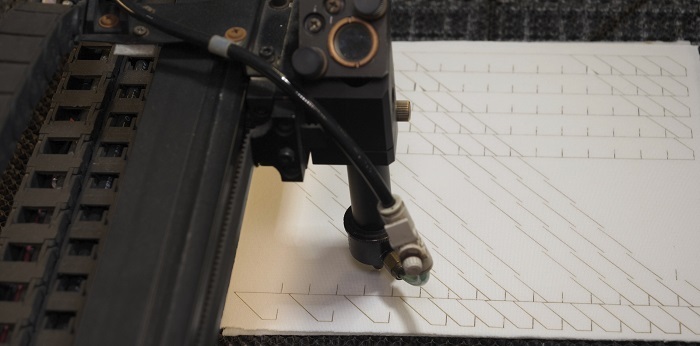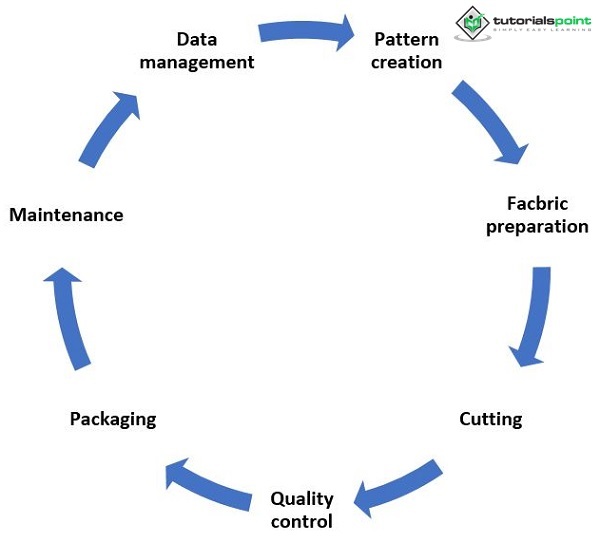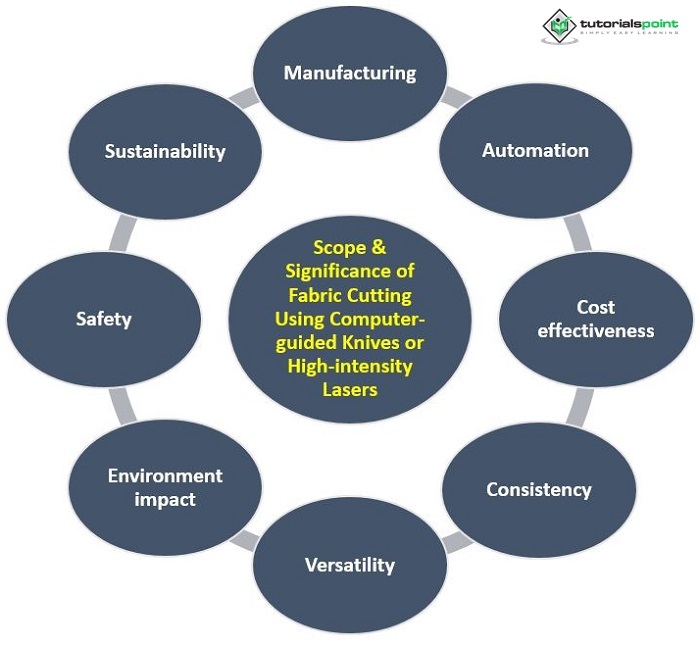

Fabric cutting using computer-guided knives or high-intensity lasers is a modern method of cutting fabric that offers precision, efficiency, and reduced waste compared to traditional cutting methods. This process uses computer software and advanced cutting technology to precisely cut fabric to the desired shape and size. The use of computer-guided knives or lasers ensures consistent and accurate cuts, making it ideal for mass production and high-volume projects.

Fabric cutting with computer-guided knives or high-intensity lasers is a method of precisely cutting fabric to the desired shape and size using advanced technology and computer software. The fabric is first laid out on a cutting table, and a digital pattern is created using specialised software. The computer then directs a knife or laser to cut the fabric along the pattern, ensuring consistent and accurate cuts every time.
This method of cutting fabric offers several benefits compared to traditional cutting methods. For one, it is much more precise, with the computer software and cutting technology eliminating human error and ensuring that each cut is accurate and consistent. Additionally, the process is much more efficient, reducing the time and labour required to cut fabric and allowing for faster and more efficient production.
Overall, fabric cutting using computer-guided knives or high-intensity lasers is an innovative and advanced method that offers improved precision, efficiency, and cost-effectiveness compared to traditional cutting methods. It is widely used in the fashion industry for mass production and high-volume projects, as well as in other industries where precise cuts are required.
Advantages of fabric cutting using computer-guided knives or high-intensity lasers include
Precision − The use of computer software and cutting technology ensures consistent and accurate cuts every time, with very little room for human error.
Efficiency − The process is much faster and more efficient than traditional cutting methods, reducing the time and labour required to cut fabric.
Reduced waste − Computer-guided cutting uses only the exact amount of fabric required for each piece, reducing waste and saving costs.
Consistency − The consistent and accurate cuts produced by computer-guided knives or lasers ensure that every piece is exactly the same, reducing the need for manual adjustments and the risk of production errors.
Improved safety − The use of computer-guided knives or lasers reduces the risk of injury compared to traditional cutting methods, which often involve manual cutting with sharp blades.
Versatility − The software and technology used for computer-guided cutting can be easily adapted to handle a wide range of fabric types and thicknesses, making it suitable for a variety of applications.
Cost-effectiveness − In addition to reducing waste and increasing efficiency, computer-guided cutting can also reduce costs in the long run by reducing the need for manual labour and minimizing production errors.
The disadvantages of fabric cutting using computer-guided knives or high-intensity lasers include
Initial cost − The initial investment in computer software, cutting technology, and other equipment can be expensive, making it a less attractive option for small or budget-conscious operations.
Technical expertise − The process requires a certain level of technical expertise, including knowledge of computer software and cutting technology, which may limit its use to trained professionals.
Limited flexibility − While computer-guided cutting is highly precise, it may not be suitable for cutting irregular or complex shapes, as the technology is limited by the digital pattern used.
Maintenance costs −The technology and equipment used for computer-guided cutting require regular maintenance and upkeep, which can be costly over time.
Dependence on technology − The process relies heavily on technology and computer software, which can be vulnerable to technical difficulties, power outages, or other issues that can disrupt production.
The technology and equipment used for computer-guided cutting may be limited in their use to certain types of fabrics or materials, making them less suitable for some applications.
The use of computer-guided knives or lasers can produce hazardous waste and emit harmful substances, which can have an environmental impact if not properly managed.
The process of fabric cutting using computer-guided knives or high-intensity lasers typically involves the following steps

Pattern creation − A digital pattern is created using specialised software, which is then used to guide the cutting process.
Fabric preparation − The fabric is prepared for cutting by laying it out flat and aligning it to the cutting bed.
Cutting − A computer-guided knife or laser is used to cut the fabric along the lines of the digital pattern, with the cutting process being guided by the software.
Quality control − The cut pieces are inspected to ensure that they match the digital pattern and are free from defects.
Packaging − The cut pieces are then packaged and prepared for use in the next stage of the production process.
Maintenance − The computer-guided knife or laser is regularly maintained to ensure that it is functioning properly and that the cutting process remains accurate and efficient.
Data management − The data from each cutting process is stored and analysed, providing valuable information for future production processes and helping to optimize the cutting process over time.
The scope and significance of fabric cutting using computer-guided knives or high-intensity lasers can be seen in the following ways

Manufacturing − This technology is widely used in the manufacturing of clothing and textiles, providing a faster, more efficient, and more precise way to cut fabric.
Automation − The use of computer-guided knives or lasers helps automate the fabric cutting process, reducing the need for manual labour and increasing productivity.
Cost-effectiveness − The increased efficiency and reduced waste of computer-guided cutting can result in lower costs and increased profitability for manufacturing operations.
Consistency − The precise and consistent cuts produced by computer-guided knives or lasers ensure that every piece is exactly the same, reducing the need for manual adjustments and the risk of production errors.
Versatility − The technology and software used for computer-guided cutting can be adapted to handle a wide range of fabrics and materials, making it suitable for a variety of applications.
Environmental impact −The use of computer-guided knives or lasers can reduce the waste produced in the fabric cutting process, helping to minimize the environmental impact of textile manufacturing.
Safety − The use of computer-guided knives or lasers reduces the risk of injury compared to traditional cutting methods, which often involve manual cutting with sharp blades.
Sustainability − The efficiency and accuracy of computer-guided cutting can help reduce the waste and environmental impact of textile manufacturing, promoting sustainable production practices.
In conclusion, fabric cutting using computer-guided knives or high-intensity lasers is a technology that has revolutionised the textile and clothing manufacturing industries. With its ability to provide precise, consistent, and efficient cuts, it has greatly improved the production process, reduced manual labour and waste, and helped to lower costs and increase profitability. The technology is also versatile and adaptable to a wide range of fabrics and materials, and it promotes environmentally friendly and sustainable production practices. As the textile industry continues to evolve and change, computer-guided cutting will likely play an increasingly important role in driving innovation and optimising production processes.